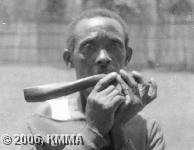
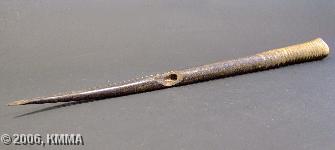
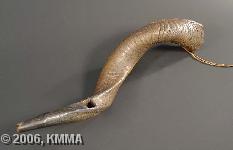
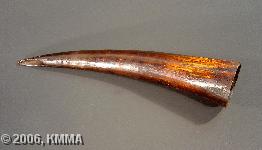
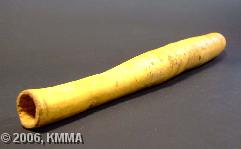
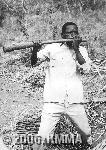
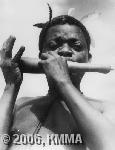
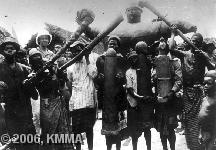
The horn is an important group of wind instruments in Africa, it includes horns from diverse antelope species or elephant’s ivory tusks with a mouthpiece at the side.
The instruments made from antelope horns are to a large extent linked to hunting, rather like the small flutes, but they also fulfil a communication function. The transmission of messages is made possible by cutting an embouchure or mouthpiece a couple of centimetres away from the tip of the horn, and by sawing off the point a small opening is created linking up the hollow inside of the instrument. By opening or closing this entrance with the thumb, the player can create two tones, allowing him to send encoded messages. This instrument is played before, during and after the hunt; to assemble the hunters, to maintain contact about their location and the position of the game, and to signal the end of the hunt. It is also used during the rituals preceding the hunt that summoning up spirits to provide protection, aid successful hunting or as a follow up to thank the hunting spirits for a good result.
The most striking horns are those made from both large and small elephant tusks. The fabrication and the function of the majority can be compared with those made from antelope horns. Ivory, the material used, lends itself well in displaying the knowledge of the sculptor or cutter. We can see in the smaller examples of the ivory horns the beautifully cut mouthpieces in various forms and/or the anthropomorphic decoration seen at the narrow tip of some of the examples. In this way we can also trace the ethnic origin of the instrument.
Undoubtedly, the most impressive are those ivory horns where the entire length of the larger tusks is used. Since these tusks are more or less the property of the chief, regarded as hunting trophies and an outward symbol of power, their position and use can be found in the entourage of the local power lords. When converted into a musical instrument, they are used primarily as a wind instrument within a larger ensemble of other musical instruments that can be considered as a ‘court orchestra’. Their appearance is also much more impressive than the smaller version used during the hunt. To emphasize even more the grandeur of this instrument some tribes cover the tip (the pavillon) with a snake or leopard skin, or an extra wooden extension is added that is also covered with an animal skin, giving it an extra sonorous quality. On the wooden extension piece in some examples from the Ekonda tribe in the Equator province, the skin is not included but the extensions are artistically engraved and painted with the typical colours (yellow, white, ochre, blue) also found in other objects from their material culture.
Finally, preserved in our collection are two additional types of horn used in the Congolese music culture and which occupy a quite individual place in the organological heritage of Central Africa. This concerns the anthropomorphic wooden ludi horn and the wooden horn made from a rudimentary thick hollow branch or root.
The Bwende (Congo) accompany the funeral dirge for a chef or influential person who has died, using anthropomorphic wooden ludi horns. On the day of the funeral, together with other wind instruments and drums, they mourn the corpse wrapped up in a gigantic cloth cocoon or nyombo (see photograph). The larger the cocoon, the more influential the deceased was during his lifetime. These ludi represent human figures (the mulumi; a male, with low tones, and the female mukazi, with higher tones) of which only the head and arms have been roughly reproduced. The trunk serves as a sounding board and the embouchure or mouthpiece is cut out on the back of the figure so that the horn, made from lightweight wood, can be carried vertically by the player. The sound these horns produce is understood by the listeners to be the voice of the soul and the personification of their ancestors. In fact these horns could also be considered as “voice amplifiers”. In contrast to the other horns from Central Africa they only produce a single note.
In the photograph, another horn type can clearly be seen, made from the branches or roots of a tree, upon which a mouthpiece is placed laterally. A preference has often been shown for the roots of trees since the inside of a root is quite tender and can be easily removed, whilst the outside is by nature extremely hard. It seems that the total sound of such a horn ensemble can penetrate bone and marrow and that the listener may experience a sense of fear at the death of a chief.
This type of instrument is used in recordings of our sound archives made with the Congolese peoples mentioned hereafter where it appears with the following vernacular names:
Agwara (Alur), Ambala (Mangbetu), Biyimi (Teke), Bondombe (Kutu), Bondule (Mongo), Bonjo (Ekonda), Chipeni (Luba, Luba-Kasai), Ega (Ndo), Ekungu (Boyela, Pygmées), Gaya (Ngbaka), Hembu (Leele), Ibuka bompulimbenda (Bolia, Ekonda), Ifonge (Boyela), Ilola (Mongo), Imponge (Djonga, Mongo), Iseke (Watsi, Yalima), Iwulu (Nyari), Kanga (Bari), Kimpungidi (Luba), Kîto (Luba), Liwakala (Nyari), Lonkenge (Mongo), Lototi (Ekonda), Luba (Gubu), Mai (Efe), Makondere (Banyoro), Masikulu (Kongo), Mbaa (Budu), Mbala (Babudu, Yogo), Mfung a nkur (Mputu), Mfung a nwan (Mputu), Mopati (Ngombe), Mpongi (Sengele), Mpungi (Mphundji) (Kongo), Mwana a mfing (Mbunda), Nambongo (Mangbetu), Nedimbo (Mangbetu), Nembo (Mangbetu), Nembongo (Mangbele), Nsingo (Yaka), Nthemfo (Kongo), Opatshi (ou Mopati) (Ngando), Ori (Bari), Pung (Kuba), Situtonga (Kouyou)
Bibliography:
Discography:
© KMMA